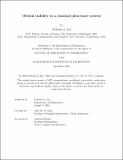Orbital stability in a classical pilot-wave system
Author(s)
Liu, Nicholas Z.
DownloadThesis PDF (7.633Mb)
Advisor
Bush, John W. M.
Terms of use
Metadata
Show full item recordAbstract
The hydrodynamic bouncing droplet system, consisting of millimetric droplets bouncing on a vibrating fluid bath, displays many quantum mechanical phenomena on a macroscopic scale. These phenomena include tunnelling, diffraction and wave-like statistics. This thesis focuses on the features responsible for the quantisation of orbital radii, and rationalises this quantisation in terms of the stability of circular orbits arising in the presence of a rotating frame and a central force. We find that orbital quantisation is most pronounced when the waves generated by each bounce decay slowly. The wave decay rate, in turn, is related to the concept of path memory, the number of prior impacts with the bath that affect the droplet’s future dynamics. We conduct an analytical investigation into the stability of circular orbits using a generalised theoretical framework that allows for an exploration of classical pilotwave dynamics both inside and outside the experimentally accessible parameter regime. The exploration of parameter regimes beyond those accessible with the hydrodynamic system reveals much richer orbital dynamics. Our novel mathematical approach allows for evaluation of the integrals appearing in the stability problem in terms of Bessel functions of complex order, and thus facilitates asymptotic expansions of the stability problem in various limits. Within the experimental parameter regime, we demonstrate that in a rotating frame, circular orbits destabilise only via resonant instabilities, for which the growing perturbations oscillate at a frequency that is an integer multiple of the orbital frequency. Conversely, in a central force, non-resonant instabilities arise, for reasons detailed herein. Outside the experimental parameter regime, we show how the non-resonant instability leads to counter-intuitive scenarios; for example, circular orbits that are stabilised by increasing memory. In the limit of vanishing particle inertia, infinite path memory and a linear spring force, we demonstrate the intriguing possibility of infinitely many sharply quantised orbital states, where the allowed orbital radii exist in vanishingly thin intervals, and are stabilised by the combined influence of the time-averaged wave field and spring force. We demonstrate that these sharply quantised orbital states are only stable for higher memory. We then consider the effect of weak external forces on spin states, circular orbits arising in the absence of external forces, and show that the destabilisation of spin states depends in a complex manner on the type of external force applied. Finally, we show that the instability of large circular orbits is related to the in-line speed oscillations of free walking droplets in a manner that is independent of the external force.
Date issued
2024-09Department
Massachusetts Institute of Technology. Department of MathematicsPublisher
Massachusetts Institute of Technology